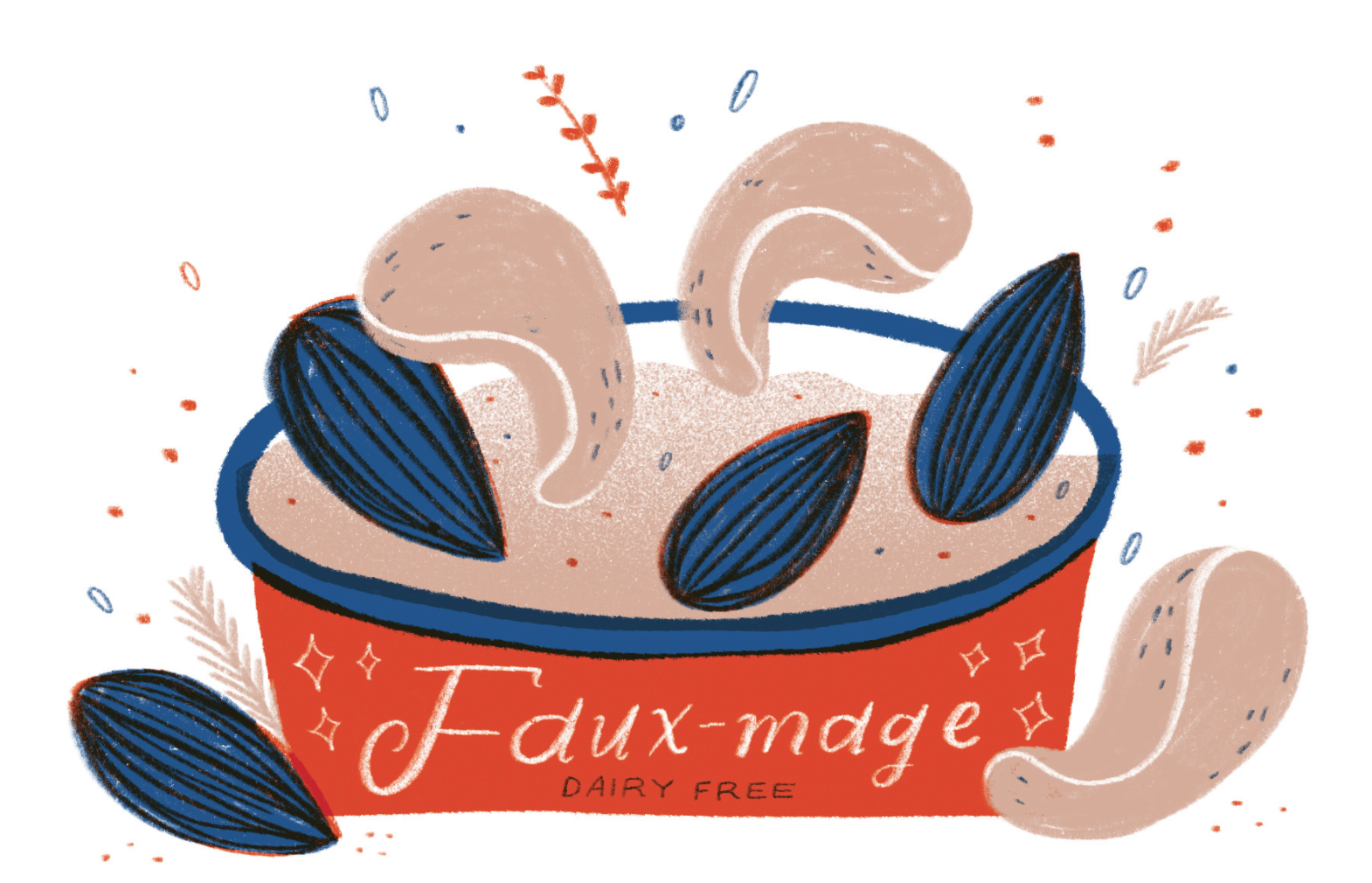
Illustration by Erin Wallace
I‘m not a vegan. I’ve become an “accidental” vegetarian (acci-tarian?) at times due to limited funds and my general fear of cooking meat. But while I respect the reasons people might electively eschew animal products, I lack the fortitude to pass up late night emergency mac and cheese in favor of ethics.
Physical sensitivity is a different story. People with lactose intolerance and dairy allergies are living in a golden age of dairy-free alternatives, some of which are quite good—I’m a big fan of coconut creamer myself. Non-dairy “cheese” brands like Daiya, Kite Hill, and Tofuttiare readily available in big name grocery stores, and have even become common cheese substitutes at many restaurants. Some brands achieve their goal better than others, serving the texture, flavor, and meltability that dairy-averse consumers crave with passable similarity.
And yet.
When my mom was stricken with a mysterious intestinal infection a few years back, she was forced to alter her diet drastically. As a child of the sixties, she was accustomed to eating and cooking mid-century staples like American chop suey, meatloaf, and lasagna. Likewise, my dad’s culinary style is dictated by the three Bs of hearty New England sustenance: beef, bread, and beans. To my parents’ credit, I was force-fed vegetables regularly as a child, but words like “kale,” “gluten,” and “dairy-free alternative” might as well have been another language. So when my mom’s meal options became limited to rice and aggressively steamed vegetables, my parents had to rewrite their entire foodscape.
My mom’s health is much better today, and now she can rattle off her preferred ancient grains, mylks, and sugar-free dessert hacks with ease. As a lifelong lover of grilled cheese, she’s experimented with a few different dairy-free cheeses that mimic the qualities of her former beloved Land-O’-Lakes slices, finally landing on an acceptable variety that maintains a permanent spot on her grocery list. When asked about her evolved relationship with vegan cheese and how it compares to the real thing, she pauses.
“It’s a…reasonable facsimile,” she says, ever the diplomat.
Dairy-free cheese isn’t exactly new. It was produced in China as far back as the 16th century from tofu and other soybean-based products. America saw a surge in vegan cheese popularity in the 1980s, as the diet craze took off and hitherto-alien words like “cholesterol”and “carbohydrate” entered the general lexicon. Dairy-free cheeses have faced a similar controversy to nut-based milks, with dairy stewards registering outrage at the words “milk” and “cheese” being co-opted to describe products that are anything but. These “reasonable facsimiles” have received mixed reviews over the years, but improvements in food production technology have done good things for texture. However, because vegan cheese does not experience the same aging process as true cheese and is made sans cultures, the nuances of flavor and mouthfeel are gone.
With a bounty of subpar options and so few truly great alternatives, I often wonder if it’s worth the effort. After all, most cheese alternatives are only good enough to remind you that you aren’t actually eating cheese. Burgers can be seasoned accordingly to make up for its absence, antipasti can replace a traditional cheese plate, and what is pizza but a bready vessel for any number of non-dairy toppings?
A friend was recently diagnosed with a dairy allergy, never before having experienced food intolerance in his life. Not quite thirty and otherwise perfectly healthy, he was blindsided. His incredibly proactive partner responded with gusto, filling their fridge with nut cheeses, tofu spreads, and compiling “cheesy” vegan pasta recipes. At a recent outing to a pizza restaurant, however, the pain on my friend’s face as he watched the rest of us enjoy our cheese-covered flatbreads was visceral, almost comical. I asked why cheese mattered to him so much.
“You just can’t replace it,” he sighed, watching me disengage a gooey slice from its fellows.



